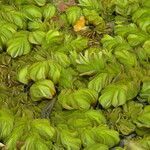Free-floating aquatic fern 5–20 cm long, often forming thick mats; rhizome to 1.2 mm thick. Foliar leaves simple, shortly petiolate, elliptical, obovate or ±round, often deeply cordate at base, 7–30 (–40) mm long, 7–20 (–25) mm wide, pale green to greenish brown, frequently overlapping and folded along midrib; margins slightly darker, entire, often incurved; apex obtuse, notched; upper surface with elongate papillae; each papilla with 4 stiff, green hairs, incurved and connate at the tips. Submerged leaf 1–20 (–30) cm long, with brown, appressed hairs. Plants usually sterile; sporogenous plants with numerous, spherical or ovoid, minutely hairy, 2–3 mm long microsporocarps in 2 rows along lobes of submerged leaf and 2 or 3 megasporocarps at the base of fertile leaf segments. Spores, when produced, deformed and not viable.
Floating fronds: lamina oblong to obovate or orbicular, ca. 2.5 × 2.4-3 cm, base rounded or cordate, apex emarginate, flat or often infolded along costa, surface abaxially with sparse pale multicellular hairs, adaxially densely papillate, papillae cylindrical, ca. 1.5(-2) mm, terminated by (2-)4 setae incurved and joined at their tips; submersed frond to 12 cm. Sporocarps in long chains of up to 55, ca. 1 mm in diam., microsporangia up to 53, megasporangia 2(or 3), more densely hairy; most sporangia empty, spores if present deformed.
Aquatic fern forming dense floating mats with lvs often tightly overlapping. Floating lvs elliptic to broadly elliptic, entire, folded, to 2.5 × 2 cm, light or brownish green, becoming somewhat darker on margins, densely covered on upper surface in papillae bearing groups of 2 or 4 uniseriate hairs united at their distal ends. Papillae to 3 mm long. Sporocarps in long straight secund chains, hairy, c. 1 mm diam., containing mostly empty sporangia.
Floating perennial with horizontal rhizome. Floating fronds in pairs, emarginate, base cordate, folded along midrib, with multicellular papillae with 4 separate curved segments adjoining apically above, submerged fronds dissected. Sporocarps spherical, hairy.
Rhizomes rootless, siphonostelic. Leaves dimorphous, borne in whorls of 3, with 2 leaves floating, oblong to orbicular, entire, variously papillate on aerial surface, third leaf submerged, finely dissected, hairy and rootlike.

